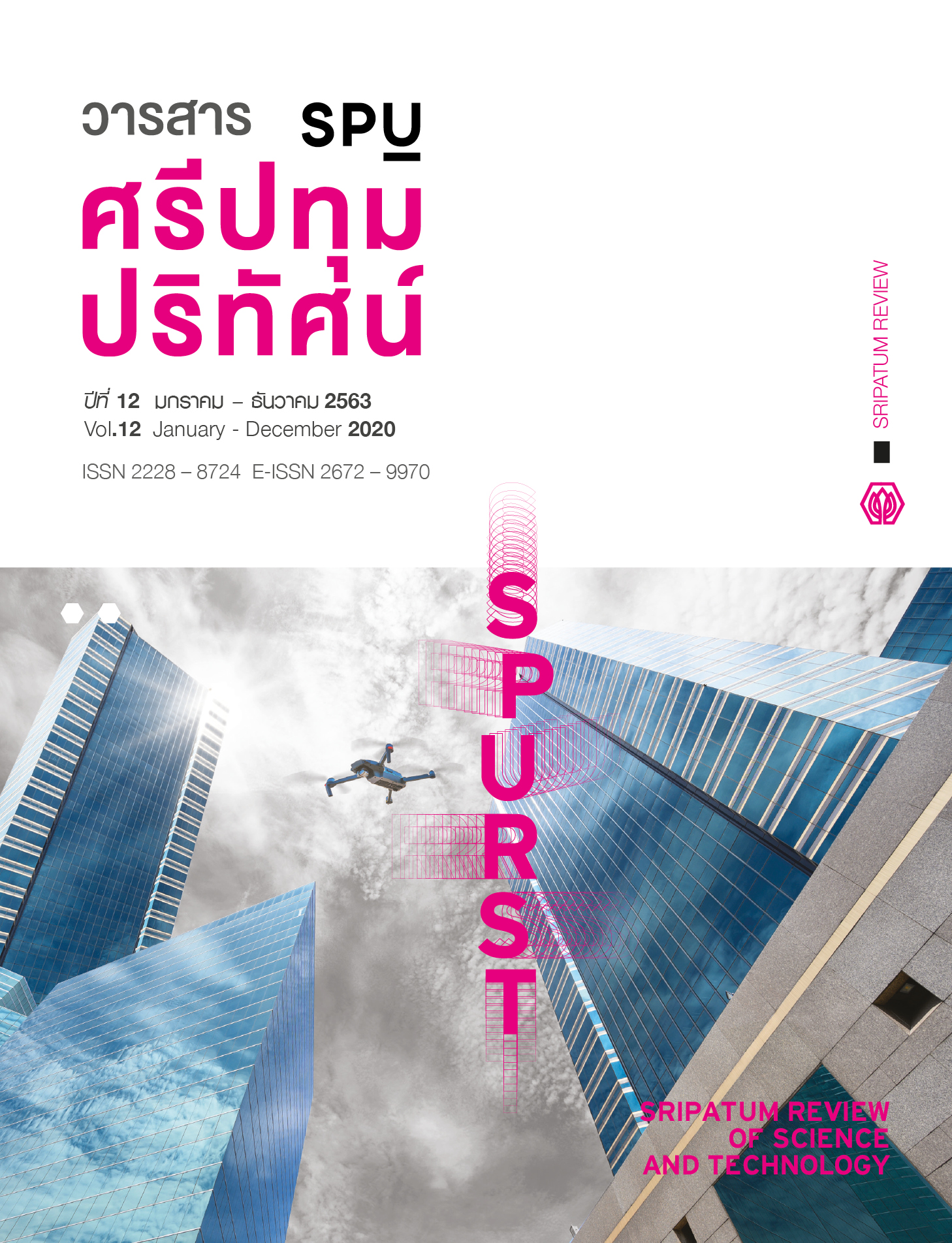การวิเคราะห์เพื่อหาจำนวนคนงานที่เหมาะสมโดยใช้เครื่องมือทางวิศวกรรมอุตสาหการ ในกระบวนการผลิตกระจกลามิเนต (The Analysis to Determine Appropriate Number of Labors by Industrial Engineering Tools in Laminate Glass Production Process )
Main Article Content
บทคัดย่อ
งานวิจัยนี้ทำการศึกษากระบวนการผลิตกระจกลามิเนตโดยมุ่งเน้นการวิเคราะห์หาจำนวนพนักงานที่เหมาะสม วัตถุประสงค์ของงานวิจัยเพื่อเพิ่มผลิตภาพแรงงาน เพิ่มประสิทธิภาพแรงงานโดยรวมของกระบวนการผลิต และลดต้นทุนค่าแรงงาน การดำเนินงานเริ่มจากศึกษากระบวนการผลิตและจำนวนแรงงานในสภาวะการทำงานปัจจุบัน เพื่อหาเวลามาตรฐานและรอบเวลาการผลิตของกระบวนการ นำไปสู่การคำนวณผลิตภาพแรงงาน ประสิทธิภาพแรงงานโดยรวม และต้นทุนค่าแรงงานก่อนปรับปรุงกระบวนการ หลังจากนั้นเครื่องมือทางวิศวกรรมกรรมอุตสาหการ คือ แผนผังกิจกรรมพหุคูณและแผนภูมิยามาซูมิ ถูกนำมาใช้เพื่อพิจารณาภาระงานของพนักงาน แต่ละคน นำไปสู่การลดจำนวนพนักงานลง จากการวิเคราะห์กระบวนการทำงานพบว่าจำนวนพนักงานที่เหมาะสมในโหลดหน้า และห้องประกบ คือ 2 คน และ 3 คน ตามลำดับ ทำให้พนักงานทั้งหมดในกระบวนการลดลงเหลือ 7 คน จากเดิม 11 คน ผลการวิจัยพบว่าผลิตภาพแรงงานและประสิทธิภาพแรงงานโดยรวมเพิ่มขึ้นร้อยละ 57.14 และ 17.01 ตามลำดับ ต้นทุนค่าแรงงานในกระบวนการผลิตกระจกลามิเนตลดลง 581,250 บาทต่อปี
Article Details
References
Athikulrat, K. (2017). Productivity Improvement by Fundamental of Hand Motions: A Case Study of Assembly Line in an Electronics Company. RMUTP Research Journal, 11(1), 165-176. (in Thai)
Cheewaworanontree, W., Rontlaong, P. and Boonrak, N. (2018). Motion and Time Study: A Case Study on A Short-Time Hydrostatic Failure Pressure Testing Process of Rigid PVC. The Journal of Industrial Technology Suan Sunandha Rajabhat Univeristy, 6(1), 26-38.
Fiallo, C. M. and Howell, G. (2012). Using Production System Design and Takt Time to Improve Project Performance. The Proceedings of 20th Conference of the International Group for Lean Construction 2012.
Kanjanapanyakom, R. (2009). Industrial Work Study. Bangkok: Top Publishing. (in Thai)
Lalitaporn, P. (2013). Production Planning and Control. Bangkok: SE-ED. (in Thai)
Phannikul, T. Sangkamanee, D. and Ngamsanga, P. (2014). Efficiency Improvement in
Manufacturing Process by Industrial Engineering Tools Case Study: Bicycle Assembly Factory. The Proceedings of Industrial Engineering Network Conference 2014, 30-31 October 2014 at Novotel Hotel Samutprakarn. (in Thai)
Poonikom, K. (2017). Efficiency Improvement in Manufacturing Process by Improvement
Technique Case Study: Drinking Water Bai-Pai-Keaw. The Proceedings of Industrial Engineering Network Conference 2017, 12-15 July 2017 at The Empress Hotel Chiangmai, 150-155. (in Thai)
Saranpracha, S. (2013). Capacity Improvement of Car-Seat Part Production Line with Toyota
Production System Concept. Engineering Journal, 5 (1), 11 – 27. (in Thai)
Sirisomphol, S. (2011). Standard Operators for Assembly Process Case Study: Assembly
Production Line Electronics Part Factory: Flexible Print Circuit. An Independent Study
of the Degree of Master of Engineering in Industrial Development. Bangkok: Thammasat University. (in Thai)
Sriwarom, T., Counaphonwiwat, T. and Manisri, C. (2014). Productivity Improvement for Dishwashing Liquid Product by Quality Function Deployment and Value Engineering. Sripatum Review of Science and Technology, 6, 57 – 67.
Sriyom, K., Chantawee, P. and Petcharat, S. (2018). The Reduction in the Loss of Rubber Latex Process by Flow Process Chart. The Journal of Industrial Technology Suan Sunandha Rajabhat Univeristy, 6(2), 13 – 23. (in Thai)
Veerasuksawad, V. Silsong, S. Khongthanasub, P. and Soontravanich, C. (2012). An Improvement of the Efficiency of Toner Cartridge Packing Process. The Proceedings of Industrial Engineering Network Conference 2012, 17-19 December 2012 at Methavalai Hotel Chaam Phetchaburi, 201 – 206. (in Thai)
Moungmoon, K., Kartea, N. and Chaikumpun, M. (2016). The Standard Time Study of Carton Corrugated Productions: Case Study Ruengchana Packing Limited Partnership. Kasem Bundit Engineering Journal, 6(1), 107 – 121.

